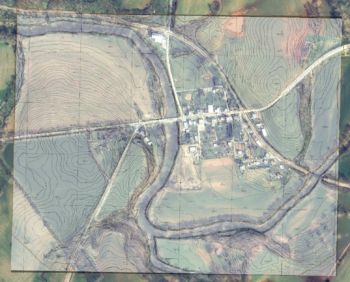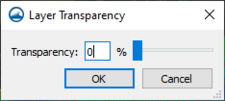SMS:Images: Difference between revisions
No edit summary |
|||
| Line 46: | Line 46: | ||
* '''Visibility''' – The visibility of an image is turned off by toggling the check box next to the image in the [[SMS:Project Explorer|Project Explorer]]. | * '''Visibility''' – The visibility of an image is turned off by toggling the check box next to the image in the [[SMS:Project Explorer|Project Explorer]]. | ||
* '''Transparency''' – The transparency of each image can be changed by right-clicking on the image in the [[SMS:Project Explorer|Project Explorer]] and selecting '''Transparency''' from the right-click menu. This brings up the ''Layer Transparency'' dialog where a slider allows adjusting the image transparency. The amount of transparency will not be shown until the '''OK''' button is clicked. | * '''Transparency''' – The transparency of each image can be changed by right-clicking on the image in the [[SMS:Project Explorer|Project Explorer]] and selecting '''Transparency''' from the right-click menu. This brings up the ''Layer Transparency'' dialog where a slider allows adjusting the image transparency. The amount of transparency will not be shown until the '''OK''' button is clicked. | ||
===Display Order=== | |||
Images are displayed in the order they appear in the Project Explorer. Images that are listed above other images in the Project Explorer will be displayed above those images in the Graphics Window. The display order can be changed by clicking-and-dragging images above or below other images in the Project Explorer. | |||
== Image Deletion == | == Image Deletion == | ||
Revision as of 15:58, 14 August 2019
At a glance
- Multiple images can be read/viewed at the same time (tiled or overlay)
- Independent transparency specified for each image
- Images can be loaded from web services as either static or dynamic images
- Images can be draped over mesh or scatter data
- Many image formats are supported including JPG, TIFF, PNG, MrSID, and ECW
- Local images can be geo-referenced to view images along with other data
- Image pyramids can be created for very large images
A background image is a digital picture detailing topographic and land use attributes of an area of interest. In SMS, these digital pictures are typically maps or aerial photos that are useful in locating and defining the boundaries of the study area and the extents and features in the project domain. Images can be imported to SMS and displayed in the background to aid in the placement of objects as they are being constructed or simply to enhance a plot. Images can also be draped or "texture mapped" or draped onto a scatter dataset (TIN) or finite element mesh.
In SMS versions 11.2, the use of images and similar raster data was greatly enhanced with the addition of the Get Online Maps... and Import from Web... commands in the Web Menu. These commands greatly simplify the acquisition and use of image data. They do require an internet connection, and may require some time to update the image data during display updates. For this reason, utilize the functionality to obtain image data then convert the image to a local static image for use with a specific project.
Supported Image File Formats
- Enhanced Compression Wavelet (*.ecw)
- Graphics Interchange Format (*.gif)
- Joint Photographic Experts Group – (*.jpg/jpeg)
- Multiresolution Seamless Image Database – (*.MrSID)
- Portable Network Graphic – (*.png)
- Tagged Image File Format – (*.tiff)
See supported file types for more information.
Importing an Image
Images can be opened in SMS using the File | Open menu command. They can also be added to a simulation by dragging and dropping the file into SMS. The images are then added to the image folder in the Project Explorer and displayed in the background to aid in the placement of objects as they are being constructed or simply to enhance visualization of the project domain. All TIFF images are converted to JPEG when they are read in. Multiple images can be imported into SMS.
Exporting Image Files
Images (or files related to images) are saved in the following ways:
Save As
The image displayed in the Graphics Window can be saved as a Bitmap Image File (*.bmp) or JPEG Image File (*.jpg, *.jpeg) using the File | Save As menu command and specifying an image file as the save as type. The resolution of the saved image is based on the screen resolution and scale factor specified in the Preferences dialog.
Project File
When a project file is saved any images that are part of the project are saved. The registration information is saved in the project file to provide the coordinate system information for the image.
Copy to Clipboard
When the Edit | Copy to Clipboard menu command is selected, the image currently displayed in the Graphics Window is copied to the clipboard. This image can then be pasted into reports or other programs by pressing CTRL + V. The resolution of the saved image is based on the screen resolution and scale factor specified in the Preferences dialog.
Export World File
A World File can be exported for the selected image by right-clicking on the Project Explorer and selecting the Export World File command. A world file is a special file that contains registration data that can be used to register images.
Geo-Referencing
A geo-referenced image includes information specifying the real world size and location of the image. The coordinate system can be embedded in the file or given in a separate file called a world file (for example: a TIFF world file, *.tfw). When geo-referenced image files are opened, SMS automatically registers the image to the real world coordinate location specified. In the case where a separate world file is used, SMS will search for it and register the image if the world file has the same filename prefix as the image file and is in the same folder.
If the image file is not geo-referenced then register the image manually. (See Registering an Image)
When the SMS project is saved, a link to the image is saved in the project file, along with the current image registration information so that the image is re-registered to the same coordinates every time the project is opened. The original image file and world file (if one exists) are not altered.
Display Options
Image display options are changed in the Project Explorer. Display options include:
- Visibility – The visibility of an image is turned off by toggling the check box next to the image in the Project Explorer.
- Transparency – The transparency of each image can be changed by right-clicking on the image in the Project Explorer and selecting Transparency from the right-click menu. This brings up the Layer Transparency dialog where a slider allows adjusting the image transparency. The amount of transparency will not be shown until the OK button is clicked.
Display Order
Images are displayed in the order they appear in the Project Explorer. Images that are listed above other images in the Project Explorer will be displayed above those images in the Graphics Window. The display order can be changed by clicking-and-dragging images above or below other images in the Project Explorer.
Image Deletion
A single image is deleted by right-clicking on the image in the Project Explorer and selecting the Remove command or pressing the Delete key.
To delete all images, right-click on the Images folder in the Project Explorer and select Clear Images (this feature was removed in SMS 12.0 and higher).
Dynamic Imagery
Starting with SMS version 11.2, dynamic imagery is available through SMS as long as SMS has access to the internet. Availability and quality of the images depend on the area being modeled and the web services available for that area and to the specific user. Many public domain web services are available in the United States and more are being made available all the time.
See Get Online Maps and Import from Web for more information about dynamic images.
From ArcGIS
For version SMS 11.0 (32-bit only), dynamic background images can be accessed from the web only through ArcGIS and only when there is an ArcGIS installation on the computer. In that version, use the GIS module within SMS to get background imagery that updates on the fly from the internet. To access these images, follow the steps below.
- Switch to the GIS module (select the globe in the bottom left of the SMS screen)
- Select Data | Enable ArcObjects
- Select Data | Add Data…
- Browse to the C:\Program Files (x86)\SMS 11.0\Supporting Files\GIS Layer Files directory
- Select the desired layer
- Select Add
Note: This feature only applies to SMS verions 11.0 and 11.1.
Related Topics
SMS – Surface-water Modeling System | ||
|---|---|---|
| Modules: | 1D Grid • Cartesian Grid • Curvilinear Grid • GIS • Map • Mesh • Particle • Quadtree • Raster • Scatter • UGrid |  |
| General Models: | 3D Structure • FVCOM • Generic • PTM | |
| Coastal Models: | ADCIRC • BOUSS-2D • CGWAVE • CMS-Flow • CMS-Wave • GenCade • STWAVE • WAM | |
| Riverine/Estuarine Models: | AdH • HEC-RAS • HYDRO AS-2D • RMA2 • RMA4 • SRH-2D • TUFLOW • TUFLOW FV | |
| Aquaveo • SMS Tutorials • SMS Workflows | ||

